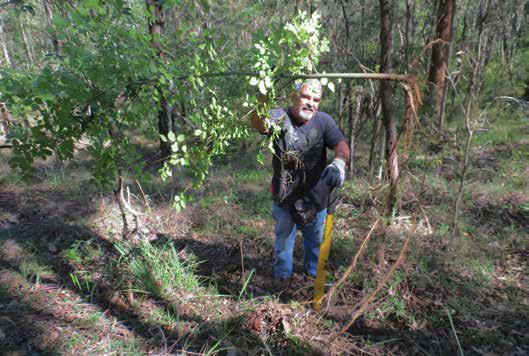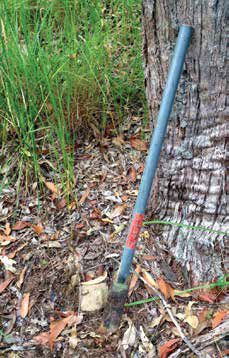So long as mature weed trees such as Camphor Laurel persist in the landscape we can expect that their seedlings will continue to germinate on our properties. Many birds feed on the fleshy fruits of camphor, privets, Chinese Elm and the like, and in doing so disperse their seeds around the landscape. If you find the seedlings while they are still small enough, they can be yanked out by hand without too much effort. However, once their roots develop to the point where they can’t be hand-pulled (without risking a hernia), there are few practical non-herbicide options available to landholders. It also has to be said that treating large numbers of saplings with the cut and paint technique is time consuming and requires a lot of bending and/or kneeling.
There is however, a growing range of tools available on the market for the manual control of weeds. While many of these are designed for the removal of relatively dainty garden weeds some are suited to, and have been specifically designed for, bush regeneration applications. The Root Blade and the Lantana Fork are examples of this and both have been pro led in previous editions of this newsletter (for Root Blade see October 2010, and Lantana Fork see January 2013).
A tool purpose built for woody weed removal to recently come on to the market is the “Tree Popper”. Like the Lantana Fork the Tree Popper offers a means of manually levering woody weeds out of the ground. Obviously it has limitations in terms of how large a plant it can remove.
The Tree Popper comes in three sizes:
- Large (7.5 kg) can remove woody weeds with a stem diameter up to 60 mm. Some people may find this model too heavy to be practical.
- Medium (5 kg) can pull stems up to 40 mm.
- Small (2.5 kg) can pull stems up to 20 mm. Given that it is lighter in weight, the small model would be the most practical for removing thickets of small seedlings.
All three sizes are effective on weeds with a stem diameter down to 5 mm.
 This large Chinese Elm sapling with extensive spreading roots was removed using a Tree Popper.
This large Chinese Elm sapling with extensive spreading roots was removed using a Tree Popper.
Photo by Mt Gravatt Environment Group (CC BY 3.0).
The Tree Popper works by grasping the sapling at the base of the stem, and then it pulls the whole plant out of the ground using the lever principle. It is claimed that the large Tree Popper has the equivalent pulling power of 10 times the weight of the operator.
While the Tree Popper doesn’t provide a non-herbicide solution for large established weed trees it does provide an alternative option for manually removing the saplings of these species. Landholders who have thickets of pine wildings will find it particularly useful. It is also suited to the removal of smaller woody shrubs such as Night-scented Jessamine (Cestrum nocturnum), Ardisia (Ardisia crispata), Indian Hawthorn (Rhaphiolepis indica) and of course Lantana.
Bushcare volunteers in Brisbane have found the Tree Popper effective for removing Ochna (Ochna serrulata), which is renowned for its difficulty to hand-pull or to kill with herbicide. The Tree Popper has also proved effective for removing plants with tap roots such as Glycine and Silver-leaf Desmodium. Like all manual weed removal techniques this tool will be most e ective if used when there is a good amount of soil moisture. One draw back of the Tree Popper is that it requires a rm surface to obtain leverage and is therefore ineffective on very soft ground such as sand.
If you have used a Tree Popper on your property we would love to hear your experiences.
 Land for Wildlife member, Sue McGruer demonstrates the Root Blade, a modified shovel designed
Land for Wildlife member, Sue McGruer demonstrates the Root Blade, a modified shovel designed
to cut through roots of woody weeds and then lever them out.
 Nick Clancy demonstrates the Lantana Fork, which is another useful bush regeneration tool designed
Nick Clancy demonstrates the Lantana Fork, which is another useful bush regeneration tool designed
to lever out woody weeds.
Another handy bush regeneration tool is the Peter Lever that has been available commercially for over 20 years. It is a versatile, nearly unbreakable tool, which is much used in the bush regeneration industry. It can be used for digging, crowning and hacking weeds such as Lantana and Ground Asparagus (Asparagus aethiopicus ‘Sprengeri’). The blade of the lever consists of recycled leaf spring (car suspension) providing its strength. It comes in two sizes, the large is 87 cm long and weighs 2.2 kg, while the smaller version is 58 cm long and weighs just 1.45 kg.
The Peter Lever works best when the blade of the tool is driven down at an angle under the plant to cut the base or roots, downwards pressure is then applied to the handle, levering the plant out of the ground. Being a relatively short tool it does have a low centre of gravity and lends itself to ground level work rather than standing.
It is especially useful for weeds that require crowning (e.g. Ground Asparagus), but is also effective for removing exotic clumping grasses such as Whiskey and Vasey Grass.
 The Peter Lever has been around for 20 years and is useful for
The Peter Lever has been around for 20 years and is useful for
digging up and hacking weeds. Shown here is the large size.
I find this tool more efficient and easier on the back for digging small holes than a shovel, spade or mattock. It is useful for planting things like lomandras and grasses that often come in half-tubes, which do not required large holes for planting.
For landholders that don’t use herbicides, the Tree Popper is useful for digging
out hard to pull weeds, such as Ochna, that would otherwise require herbicide treatment to kill.
Article by Nick Clancy Land for Wildlife Officer Sunshine Coast Council

Hi I am a land for wildlife member for some years on my 74 acre hilly property. I have lots of lantana and have battled it off and on for years. I built a heavy duty lantana fork. Works OK though pretty heavy and I managed to bend the two prongs of the 10mm steel prongs. Still useable though. How do I get hold of can I make one of these Tree Poppers if more useable than the above. Live near Dayboro and looking for a Operator to mechanically remove lantana if you know anyone.
Cheers Mike
Hi Mike
Tree Poppers can be purchased via http://www.treepopper.com.au/
I would also recommend you getting in touch with your local Land for Wildlife Officer at Moreton Bay Regional Council. Through Council, they may be able to offer you some support to manage the lantana. Phone details for your Land for Wildlife Officers can be found on page 2 of any edition of the Land for Wildlife newsletter. https://www.lfwseq.org.au/newsletters/
Hope that helps.
Where can I buy a Lantana Fork , looks like the tool I need to pull Broom and Silver Wattle .
Hi Barry. We are not sure if the Lantana Fork is still commercially available. It was made by a small business out of Toowoomba and we cannot find it online. You may need to manufacture one yourself! Sorry.
Hi I have a 3Ha site near Kilcoy that needs a lot of weed control – but not sure if it is worth buying a new tree popper for $600. Does anyone have a second hand (Large) Tree popper for sale/hire?
Many thanks,
Peter D